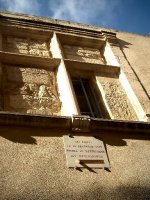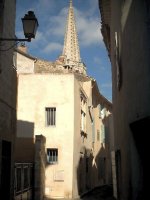| 
The original façade
of the Nostradamus house. The sign reads: "Here was
born on 14 December 1503 Michel de Nostredame called Nostradamus"

A long shot of the
Nostradamus house with the St. Rémy church in the background.
|
On the way back, I stopped in nearby
St.-Rémy-de-Provence because I had read that it had
a lovely town center and I also needed to thaw out. The
vielle ville is a collection of old streets and
buildings encircled by the main thoroughfare. I needed to
get a map and some stamps so I wandered around the downtown
area looking for a bookstore and a tabac. I eventually
found both but as I turned one corner I saw a sign on the
façade of one building claiming it as the birthplace
of Nostradamus. St. Rémy’s most notable resident
was van Gogh, who committed himself to the psychiatric hospital
here. While in St. Rémy, van Gogh was inspired by
the surroundings to create 250 paintings and drawings –
in a single year! And I'm still working on my kitchen.
I finally settled outside a café
(this was only possible if you sat in the sun) where I had
my first pastis. A Fenchman who fled to Switzerland
after the revolution developed pastis using the
ingredients he had handy. Upon his death, his wife sold
the recipe to a frenchman named Pernot who was passing through
town. Pastis was originally based on absinthe,
liquor made with wormwood, but was illegalized because the
wormwood imparted a hallucinogenic oil to the aperitif.
Some argue that this potent drink was the inspiration for
many of the great artists who painted in Provence. Anyway,
it was reformulated using anise as the main ingredient for
many years, but now is allowed to be made with strictly
controlled levels of wormwood. Basically, it tastes like
licorice and is a little sweet for me, but when in Rome….
|

